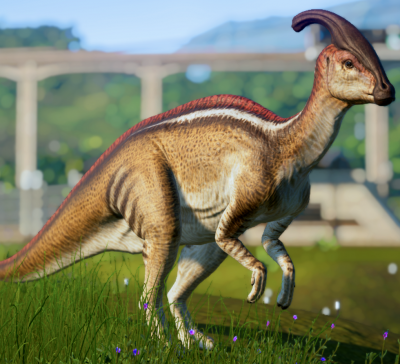
Parasaurolophus is a hadrosaurid (sometimes referred to as the hadrosaurs or duck-billed dinosaurs) from approximately 76.5–73 million years ago (late Cretaceous). It is a herd animal feeding on the park’s rich vegetation. The most stunning feature of the Parasaurolophus is the crest on its head
Parasaurolophus was a hadrosaurid, part of a diverse family of Cretaceous dinosaurs known for their range of bizarre head adornments. This genus is known for its large, elaborate cranial crest, which at its largest forms a long curved tube projecting upwards and back from the skull. Charonosaurus from China, which may have been its closest relative, had a similar skull and potentially a similar crest. Visual recognition of both species and sex, acoustic resonance, and thermoregulation have been proposed as functional explanations for the crest. It is one of the rarer hadrosaurids, known from only a handful of good specimens.
The most noticeable feature was the cranial crest, which protruded from the rear of the head and was made up of the premaxilla and nasal bones. The crest was hollow, with distinct tubes leading from each nostril to the end of the crest before reversing direction and heading back down the crest and into the skull. The tubes were simplest in P. walkeri, and more complex in P. tubicen, where some tubes were blind and others met and separated. While P. walkeri and P. tubicen had long crests with only slight curvature, P. cyrtocristatus had a short crest with a more circular profile.
Picture Credit : Google




